DRAM (for dynamic random-access memory) is a type of random-access memory (RAM) that consists of a transistor and a capacitor, storing one bit on the capacitor. It’s an example of a volatile memory, as electrons are leaked through the transistor and capacitor, meaning it requires a refresh operation.
 It’s much denser than static RAM, but it needs a constant refresh, where we occasionally read and re-write the cell. This is done periodically at 64 ms.
It’s much denser than static RAM, but it needs a constant refresh, where we occasionally read and re-write the cell. This is done periodically at 64 ms.
Synchronous DRAM (SDRAM) has read and write relative to a clock.